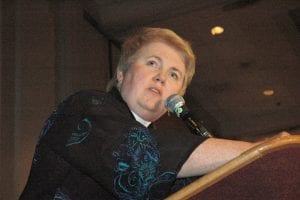April Larson

Photo used with permission of the ELCA Archives
In 1992, the La Crosse Area Synod elected Rev. April Ulring Larson as their bishop. At the time, Larson was living in Rochester, Minnesota, in a completely different synod. Yet, she was still elected. She has attributed this to her position as a song leader at the celebration service for the 20th anniversary of women’s ordination, which allowed her to demonstrate her leadership abilities on a national Lutheran stage. Female clergy around the nation rejoiced because this decision affected not only La Crosse but the entire ELCA, as it made April Larson the first female bishop in the ELCA. Over 20 years after the ordination of the first Lutheran woman in America, the time had arrived for the voices of half the church population to be heard and the first female bishop to be elected.
The position of bishop was a significant jump from where Larson’s career had begun 14 years prior. A member of the first generation of Lutheran women to achieve ordination, Larson had attended Wartburg Theological Seminary alongside her husband, Judd Larson, and both were ordained in 1978. As is common among female clergy, for the first eleven years of her ministry Larson served as a co-pastor alongside her husband. Female clergy were – and still are – disproportionately more likely to be married to another clergy member than are male clergy. (Zikmund et al. Chp 2.) Larson has recalled the challenges of this situation, saying, “It was very difficult in the sense that people would readily and quickly call my husband pastor and would just about choke at calling me pastor.” (LA Times). For many years, Larson worked alongside her husband while they raised their three children: Katie, Amy, and Ben.
Larson has described being shocked by her election and plagued by worries about her ability to succeed. Despite having qualification from her position as the Assistant to the Bishop of the Southeastern Minnesota Synod from 1989 to 1992, Larson felt the pressure of other aspiring female Lutheran leaders looking up to her. Over time, however, Larson came to recognize the power of her position – not only to make administrative accomplishments but also to serve as a symbol of the institutional change in the ELCA. In her essay “The Opening Door of Pentecost,” Larson discusses the symbolic power of her election. A female bishop, she says, demonstrates that women are holy enough to be anywhere within the church; no position is held back from them. She also discusses the symbolism of a female figurehead, a woman who is able to physically represent all of humanity within the church. It legitimates the female voice as speaking to the human experience, not just the female experience. Larson herself filled this symbolic and important role for 16 years, serving 3 terms in total. Her election as the first female bishop was important because it empowered women within the church and encouraged them to become clergy if they felt called to do so.
References
